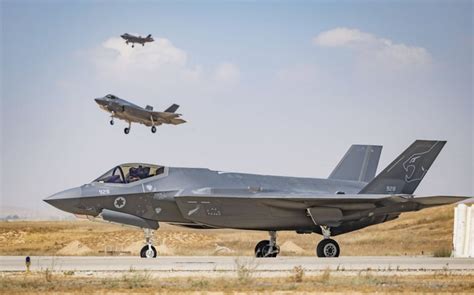
Israel’s advanced F-35I Adir stealth fighter jets, costing approximately $44,000 per flight hour, are reportedly being positioned as a critical component in a potential military strategy to neutralize Iran’s nuclear facilities. Recent images and reports highlight the advanced capabilities of these aircraft and their strategic importance in addressing escalating tensions with Iran over its nuclear program.
Amid rising concerns over Iran’s nuclear ambitions, Israel is increasingly relying on its fleet of F-35I Adir stealth fighter jets as a potential deterrent and, if necessary, a tool for military intervention. These advanced aircraft, costing an estimated $44,000 per flight hour, represent a significant investment in Israel’s defense capabilities and are central to its strategy for addressing perceived existential threats. The deployment and readiness of the F-35I fleet underscore Israel’s commitment to preventing Iran from developing nuclear weapons, a position that has been reiterated by numerous Israeli officials.
The F-35I Adir, a highly customized version of the American-made F-35 Lightning II, incorporates unique Israeli technologies and modifications to meet the specific operational requirements of the Israeli Air Force (IAF). These enhancements include advanced electronic warfare systems, command and control capabilities, and weapon systems, providing Israel with a distinct advantage in regional military operations. The stealth capabilities of the F-35I are particularly crucial, enabling it to penetrate heavily defended airspace and evade sophisticated radar systems, making it an ideal platform for potential strikes against Iranian nuclear sites, which are often located deep underground and heavily fortified.
The potential use of the F-35I Adir in a military operation against Iran is not merely speculative. High-ranking Israeli military officials have openly discussed the possibility of such a scenario, emphasizing that all options are on the table to prevent Iran from acquiring nuclear weapons. These statements, combined with ongoing military exercises simulating strikes on Iranian nuclear facilities, demonstrate the seriousness with which Israel views the threat. The F-35I, with its advanced capabilities and strategic importance, is at the forefront of these considerations.
While a military strike against Iran would be a significant escalation with far-reaching consequences, Israel maintains that it cannot afford to allow Iran to develop nuclear weapons. The country’s leaders have stated this poses an unacceptable threat to Israel’s existence. The F-35I Adir, therefore, is not just a symbol of Israel’s military might but a key instrument in its strategy to deter Iran and, if necessary, to defend itself against what it perceives as an imminent threat.
The Israeli Air Force has been conducting extensive training exercises to prepare for a potential strike on Iranian nuclear facilities. These exercises include long-range flights, aerial refueling operations, and simulated attacks on heavily defended targets. The F-35I Adir plays a central role in these exercises, allowing pilots to hone their skills in penetrating hostile airspace and delivering precision strikes. These training missions are designed to ensure that the IAF is fully prepared to execute a military operation against Iran should the need arise.
The decision to use the F-35I Adir in a military strike against Iran would be a complex and consequential one, involving numerous political, strategic, and military considerations. The potential ramifications of such an action are immense, including the risk of a wider regional conflict, economic instability, and significant loss of life. However, Israel views the threat of a nuclear-armed Iran as an existential one, justifying the consideration of military options as a last resort.
The United States, Israel’s closest ally, has consistently stated its commitment to preventing Iran from acquiring nuclear weapons. While the U.S. prefers a diplomatic solution, it has also indicated that all options are on the table, including military action. The coordination between the U.S. and Israel on this issue is crucial, and the two countries have been engaged in extensive consultations to develop a comprehensive strategy for addressing the Iranian nuclear threat. The role of the F-35I Adir in any potential military operation would likely be coordinated with the U.S. military to ensure maximum effectiveness and minimize the risk of unintended consequences.
The F-35I Adir’s technological superiority provides Israel with a significant military advantage. Its stealth capabilities, advanced sensors, and precision strike capabilities make it a formidable weapon system. However, a military strike against Iran would not be without its challenges. Iran has invested heavily in its air defense systems, and its nuclear facilities are heavily fortified. Furthermore, Iran could retaliate against Israel through its proxies in the region, such as Hezbollah and Hamas, potentially leading to a wider conflict.
Despite these challenges, Israel remains determined to prevent Iran from acquiring nuclear weapons. The F-35I Adir is a key component of its strategy to achieve this goal, providing Israel with the capability to deter Iran and, if necessary, to defend itself against what it perceives as an existential threat. The future of the region hinges on the outcome of this ongoing confrontation, and the F-35I Adir will likely play a central role in shaping that future.
Beyond its role in a potential strike against Iran, the F-35I Adir also serves as a symbol of Israel’s technological prowess and its commitment to maintaining a qualitative military edge in the region. The development and deployment of this advanced aircraft have bolstered Israel’s confidence and enhanced its ability to deter potential adversaries. The F-35I Adir is not just a weapon system; it is a strategic asset that strengthens Israel’s overall security posture.
The acquisition of the F-35I Adir has also had a significant impact on the regional balance of power. The aircraft’s advanced capabilities have raised concerns among Israel’s neighbors, particularly Iran and Syria, which view it as a threat to their own security. The presence of the F-35I Adir in the region has heightened tensions and increased the risk of miscalculation, making it even more important to manage the situation carefully and avoid any actions that could escalate the conflict.
The F-35I Adir program represents a significant investment in Israel’s future security. The aircraft is expected to remain in service for several decades, providing Israel with a cutting-edge military capability that will help it maintain its qualitative military edge in the region. The ongoing development and upgrade of the F-35I Adir will ensure that it remains a relevant and effective weapon system for years to come.
The strategic importance of the F-35I Adir extends beyond its military capabilities. The aircraft also serves as a symbol of the close relationship between the United States and Israel. The U.S. has provided Israel with significant military assistance over the years, including the F-35I Adir, which has helped to strengthen Israel’s security and deter potential adversaries. The ongoing cooperation between the U.S. and Israel on defense matters is a key element of the overall strategic partnership between the two countries.
The deployment of the F-35I Adir has also had a positive impact on Israel’s economy. The aircraft is manufactured by Lockheed Martin, but Israeli companies are involved in the production of some of its components. This has created jobs and stimulated economic growth in Israel, further strengthening the country’s economy.
The F-35I Adir is a complex and sophisticated weapon system that requires highly trained personnel to operate and maintain. The Israeli Air Force has invested heavily in training its pilots and maintenance crews to ensure that they are fully capable of utilizing the aircraft’s advanced capabilities. The ongoing training and development of personnel are essential to ensuring that the F-35I Adir remains an effective weapon system.
The F-35I Adir is not a panacea for all of Israel’s security challenges. However, it is a valuable asset that enhances Israel’s ability to deter potential adversaries and defend itself against threats. The aircraft’s advanced capabilities, combined with Israel’s strong military and intelligence capabilities, provide the country with a significant advantage in the region.
The future of the F-35I Adir program is uncertain. The program has faced some technical challenges and cost overruns, but the aircraft is expected to remain in service for many years to come. The ongoing development and upgrade of the F-35I Adir will ensure that it remains a relevant and effective weapon system.
The F-35I Adir is a testament to Israel’s ingenuity and its commitment to maintaining a strong and capable military. The aircraft is a symbol of Israel’s determination to defend itself against threats and to ensure its survival in a volatile region. The F-35I Adir will continue to play a central role in Israel’s security strategy for years to come.
The decision to potentially deploy the F-35I Adir against Iran is a reflection of the deep-seated concerns within Israel regarding Iran’s nuclear ambitions. This concern transcends political divides and is rooted in a historical context marked by regional conflicts and perceived existential threats. The Israeli perspective is shaped by a belief that a nuclear-armed Iran would fundamentally alter the strategic landscape, posing an unacceptable risk to Israel’s security and stability.
The potential use of the F-35I Adir is not solely a military matter but also a political and diplomatic one. Israel is acutely aware of the international implications of any military action against Iran and is likely to coordinate closely with its allies, particularly the United States, to ensure that its actions are understood and supported. The decision to strike Iran would be a last resort, taken only after all other options have been exhausted.
The F-35I Adir represents a significant advancement in Israel’s military capabilities, but it also highlights the ongoing arms race in the Middle East. Other countries in the region are also investing in advanced weapon systems, further escalating tensions and increasing the risk of conflict. The F-35I Adir is a powerful symbol of Israel’s military strength, but it is also a reminder of the challenges facing the region and the importance of finding peaceful solutions to its conflicts.
The F-35I Adir program has also generated some controversy within Israel. Some critics argue that the aircraft is too expensive and that the money could be better spent on other priorities. Others question the effectiveness of stealth technology in a region where radar systems are becoming increasingly sophisticated. Despite these criticisms, the F-35I Adir remains a key element of Israel’s defense strategy and is widely seen as a valuable asset.
The F-35I Adir is a symbol of Israel’s resilience and its determination to survive in a hostile environment. The aircraft represents a significant investment in the country’s future security and reflects its commitment to maintaining a strong and capable military. The F-35I Adir will continue to play a central role in Israel’s defense strategy for years to come.
The Iranian response to any potential Israeli strike using the F-35I Adir is difficult to predict. However, it is likely that Iran would retaliate in some form, either directly or through its proxies in the region. This could lead to a wider conflict with devastating consequences. The risks associated with a military strike against Iran are significant, and any decision to take such action would be weighed very carefully.
The F-35I Adir is not just a weapon system; it is a symbol of Israel’s national identity and its determination to defend itself against all threats. The aircraft represents a significant investment in the country’s future and reflects its commitment to maintaining a strong and capable military. The F-35I Adir will continue to play a central role in Israel’s defense strategy for years to come.
The ongoing tensions between Israel and Iran are a major source of instability in the Middle East. The potential for a military conflict between the two countries is a constant threat, and the F-35I Adir is a key element in Israel’s strategy for deterring Iran and defending itself against any potential attack. The situation is complex and volatile, and the future of the region remains uncertain.
The F-35I Adir is a reminder of the challenges facing Israel and the importance of maintaining a strong and capable military. The aircraft represents a significant investment in the country’s future security and reflects its commitment to defending itself against all threats. The F-35I Adir will continue to play a central role in Israel’s defense strategy for years to come.
Frequently Asked Questions (FAQ)
1. What is the F-35I Adir, and why is it important to Israel?
The F-35I Adir is a highly advanced, fifth-generation stealth fighter jet, a customized version of the American-made F-35 Lightning II. It is crucial for Israel because it provides a significant technological advantage in the region. Its stealth capabilities allow it to penetrate heavily defended airspace, and its advanced sensors and precision strike capabilities make it a formidable weapon system. “The F-35I Adir, a highly customized version of the American-made F-35 Lightning II, incorporates unique Israeli technologies and modifications to meet the specific operational requirements of the Israeli Air Force (IAF).” It enhances Israel’s deterrence capabilities and ability to respond to potential threats, particularly from Iran.
2. What is the estimated cost per flight hour of the F-35I Adir?
The estimated cost per flight hour of the F-35I Adir is approximately $44,000. This high cost reflects the advanced technology and maintenance requirements associated with operating a fifth-generation fighter jet. The investment is considered worthwhile by Israel, given the strategic importance of the aircraft in maintaining its qualitative military edge.
3. Why is Israel considering using the F-35I Adir against Iran?
Israel views Iran’s nuclear program as an existential threat and is concerned that Iran is developing nuclear weapons. Israel has stated that it will not allow Iran to acquire nuclear weapons and is prepared to use military force, if necessary, to prevent this. The F-35I Adir is considered a key component in a potential military strategy to neutralize Iran’s nuclear facilities due to its stealth capabilities and precision strike capabilities. “While a military strike against Iran would be a significant escalation with far-reaching consequences, Israel maintains that it cannot afford to allow Iran to develop nuclear weapons. The country’s leaders have stated this poses an unacceptable threat to Israel’s existence.”
4. What are the potential risks and consequences of a military strike against Iran using the F-35I Adir?
A military strike against Iran would be a significant escalation with far-reaching consequences. Potential risks include:
- Regional Conflict: A strike could trigger a wider regional conflict involving Iran, Israel, and other countries in the Middle East.
- Retaliation: Iran could retaliate against Israel through its proxies in the region, such as Hezbollah and Hamas.
- Economic Instability: A conflict could disrupt oil supplies and destabilize the global economy.
- Loss of Life: A military strike would likely result in significant loss of life on both sides.
Despite these risks, Israel maintains that the threat of a nuclear-armed Iran is an existential one, justifying the consideration of military options as a last resort.
5. How does the United States view Israel’s potential use of the F-35I Adir against Iran?
The United States has consistently stated its commitment to preventing Iran from acquiring nuclear weapons. While the U.S. prefers a diplomatic solution, it has also indicated that all options are on the table, including military action. The U.S. and Israel have been engaged in extensive consultations to develop a comprehensive strategy for addressing the Iranian nuclear threat. “The coordination between the U.S. and Israel on this issue is crucial, and the two countries have been engaged in extensive consultations to develop a comprehensive strategy for addressing the Iranian nuclear threat.” The role of the F-35I Adir in any potential military operation would likely be coordinated with the U.S. military to ensure maximum effectiveness and minimize the risk of unintended consequences.
6. What are some of the unique Israeli technologies incorporated into the F-35I Adir?
The F-35I Adir incorporates unique Israeli technologies to meet the specific operational requirements of the Israeli Air Force. These enhancements include advanced electronic warfare systems, command and control capabilities, and weapon systems. The exact details of these technologies are often classified, but they are designed to enhance the aircraft’s performance and effectiveness in the regional environment.
7. What kind of training exercises has the Israeli Air Force conducted to prepare for a potential strike on Iranian nuclear facilities?
The Israeli Air Force has conducted extensive training exercises to prepare for a potential strike on Iranian nuclear facilities. These exercises include:
- Long-Range Flights: Simulating the distance required to reach Iranian targets.
- Aerial Refueling Operations: Practicing in-flight refueling to extend the aircraft’s range.
- Simulated Attacks on Heavily Defended Targets: Rehearsing strikes against fortified targets similar to Iranian nuclear sites.
- The F-35I Adir plays a central role in these exercises, allowing pilots to hone their skills in penetrating hostile airspace and delivering precision strikes.
8. How does the acquisition of the F-35I Adir affect the regional balance of power in the Middle East?
The acquisition of the F-35I Adir has a significant impact on the regional balance of power. Its advanced capabilities have raised concerns among Israel’s neighbors, particularly Iran and Syria, which view it as a threat to their own security. The presence of the F-35I Adir in the region has heightened tensions and increased the risk of miscalculation.
9. Beyond its potential military use, what other benefits does the F-35I Adir bring to Israel?
Beyond its potential military use, the F-35I Adir brings several other benefits to Israel:
- Technological Prowess: It serves as a symbol of Israel’s technological prowess and its commitment to maintaining a qualitative military edge.
- Economic Impact: Israeli companies are involved in the production of some of its components, creating jobs and stimulating economic growth.
- Strategic Partnership: It strengthens the close relationship between the United States and Israel, as the U.S. has provided Israel with significant military assistance, including the F-35I Adir.
10. What are some of the challenges and criticisms associated with the F-35I Adir program?
The F-35I Adir program has faced some challenges and criticisms:
- Cost Overruns: The program has experienced some cost overruns, raising concerns about its affordability.
- Technical Challenges: The aircraft has faced some technical challenges, although these are being addressed.
- Effectiveness of Stealth Technology: Some critics question the effectiveness of stealth technology in a region where radar systems are becoming increasingly sophisticated.
Despite these criticisms, the F-35I Adir remains a key element of Israel’s defense strategy.
11. What is the likelihood of a military strike against Iran using the F-35I Adir?
The likelihood of a military strike against Iran using the F-35I Adir is difficult to predict and depends on several factors, including:
- Iran’s Nuclear Program: If Iran continues to advance its nuclear program, the likelihood of a strike increases.
- Diplomatic Efforts: If diplomatic efforts to resolve the issue fail, the likelihood of a strike increases.
- Regional Tensions: If tensions in the region continue to escalate, the likelihood of a strike increases.
Israel has repeatedly stated that it will not allow Iran to acquire nuclear weapons and is prepared to use military force if necessary. However, a military strike would be a last resort, taken only after all other options have been exhausted.
12. What other military assets does Israel have that could be used in a potential strike against Iran?
In addition to the F-35I Adir, Israel has a range of other military assets that could be used in a potential strike against Iran, including:
- F-15I Strike Eagles: Long-range strike fighters.
- F-16I Sufa: Multirole fighter jets.
- Submarines: Capable of launching cruise missiles.
- Drones: For reconnaissance and surveillance.
- Ground-Based Missiles: For long-range strikes.
Israel’s military is highly capable and well-equipped, and it has the ability to conduct a wide range of military operations.
13. How might Iran respond to a military strike using the F-35I Adir?
Iran’s response to a military strike using the F-35I Adir is difficult to predict, but potential responses could include:
- Direct Retaliation: Iran could launch missiles and drones against Israel.
- Proxy Attacks: Iran could use its proxies in the region, such as Hezbollah and Hamas, to attack Israel.
- Cyber Attacks: Iran could launch cyber attacks against Israeli infrastructure.
- Disruption of Shipping: Iran could attempt to disrupt shipping in the Strait of Hormuz.
The risks associated with a military strike against Iran are significant, and any decision to take such action would be weighed very carefully.
14. How has the development of the F-35I Adir program impacted the Israeli defense industry?
The development of the F-35I Adir program has had a positive impact on the Israeli defense industry. Israeli companies have been involved in the production of some of the aircraft’s components, creating jobs and stimulating economic growth. The program has also helped to foster innovation and technological development within the Israeli defense industry.
15. What are the long-term strategic implications of Israel possessing the F-35I Adir?
The long-term strategic implications of Israel possessing the F-35I Adir are significant:
- Enhanced Deterrence: It enhances Israel’s ability to deter potential adversaries.
- Regional Power: It reinforces Israel’s position as a regional power.
- Qualitative Military Edge: It helps Israel maintain its qualitative military edge in the region.
- Strategic Flexibility: It provides Israel with greater strategic flexibility in responding to threats.
- The F-35I Adir is a valuable asset that will continue to play a central role in Israel’s defense strategy for years to come.
16. How does the cost of the F-35I Adir compare to other advanced fighter jets?
The F-35I Adir is one of the most expensive fighter jets in the world, but its cost is comparable to other advanced fifth-generation fighters. The high cost reflects the advanced technology and capabilities of these aircraft. While the initial acquisition cost is high, the long-term operational costs are expected to be lower than those of older-generation fighter jets due to improved maintenance and reliability.
17. What are the key performance characteristics of the F-35I Adir?
The key performance characteristics of the F-35I Adir include:
- Stealth: Its stealth capabilities make it difficult to detect by radar.
- Advanced Sensors: It is equipped with advanced sensors for reconnaissance and surveillance.
- Precision Strike Capabilities: It can deliver precision strikes against a wide range of targets.
- Air-to-Air Combat Capabilities: It is capable of engaging in air-to-air combat.
- Long Range: It has a long range, allowing it to reach distant targets.
- Advanced Electronic Warfare Systems: It is equipped with advanced electronic warfare systems for jamming and deception.
18. How does the F-35I Adir integrate with other Israeli military systems?
The F-35I Adir is designed to integrate seamlessly with other Israeli military systems, including:
- Air Defense Systems: It can share data with Israeli air defense systems to improve situational awareness.
- Intelligence Networks: It can receive intelligence data from Israeli intelligence networks.
- Command and Control Systems: It can be integrated into Israeli command and control systems.
This integration enhances the overall effectiveness of the Israeli military.
19. What are the potential ethical considerations associated with using the F-35I Adir in a military strike?
The potential ethical considerations associated with using the F-35I Adir in a military strike include:
- Proportionality: Ensuring that the use of force is proportionate to the threat.
- Discrimination: Minimizing the risk of civilian casualties.
- Collateral Damage: Avoiding unnecessary damage to civilian infrastructure.
- International Law: Complying with international law and the laws of war.
These ethical considerations must be carefully weighed before any decision is made to use military force.
20. What is the future of the F-35I Adir program?
The future of the F-35I Adir program appears to be secure. Israel plans to continue acquiring and upgrading the aircraft, ensuring that it remains a key element of its defense strategy. The ongoing development and integration of new technologies will further enhance the aircraft’s capabilities and effectiveness. The F-35I Adir is expected to play a central role in Israel’s security for decades to come.









